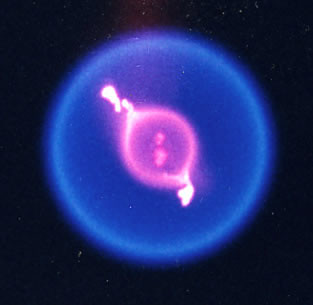Video: Fighting fires in space

NASA’s Flame Extinguishment Experiment (FLEX) which has run for the past three years and ended in December 2011, has provided insight into how fires behave in a space craft, where there is no up or down. And if we know a bit about how fires behave in space then we can have a better idea of how to fight such fires which is useful in small spaces like the kind found in the International Space Station.
Researchers performed over 200 experiments igniting a drop of heptane or methanol. The bubble of fuel becomes a spherically symmetric flame (as you can see in the video below), that shrinks as it burns fuel.
Fire in space burns at a lower temperature and rate—nearly 100 times slower—and with less oxygen than in normal gravity. So materials used to extinguish fires in space must be in higher concentrations. The International Space Station has CO2 fire extinguishers and the researchers tested how flames burn in the presence of different concentrations of CO2. Perhaps most useful for the space station, the FLEX experiments determined an index for completely fire-safe air. Meaning, the limit where there is not enough oxygen in the air for fuel to ignite. The team found this limiting oxygen index for methanol and heptane.
But there are other very strange phenomena that the team continues to try and explain. When the flame around a fuel droplet dies out, even if fuel is still available, the droplet should stop shrinking. This is how combustion typically works. But there were instances during the FLEX studies where heptane droplets continued to shrink at the same rate as they did when surrounded in flame. The lead researcher Forman Williams—who has been studying fires since for 50 years—has never seen anything like this. It’s as if the heptane continues to burn with no fire. A good enough reason to keep studying. FLEX-2 started this year and will continue through 2012.
This post was originally published on Smartplanet.com
